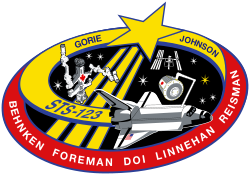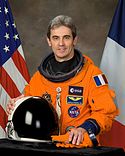Léopold Eyharts
| Léopold Eyharts | |
|---|---|
 | |
| ESA Astronaut | |
| Statsborger | Frankrig |
| Nationalitet | Fransk |
| Status | Aktiv |
| Født | 28. april 1957 Alder 63 Biarritz, Frankrig |
Andet arbejde | Ingeniør, Testpilot |
| Uddannelses- sted | École de l'Air |
| Rang | Brigadegeneral i det franske luftvåben |
Tid i rummet | 68d 21t 31m |
| Udvælgelse | CNES 1990 |
| Mission(er) | Sojuz, STS-122, Ekspedition 16, STS-123 |
| Missionsemblemer | |
Léopold Eyharts (født 28. april 1957) er en ESA-astronaut og har indtil videre været to gange i rummet; 20 dage på Mir i 1998 og 33 dage på ISS i 2008.
Léopold Eyharts er ingeniøruddannet og testpilot. Han har været jagerpilot, deltaget i Buranprogrammet, det aflyste Hermes-rumfærgeprogram og været leder af Airbus A300-testflyvningerne.
Som led i den franske rumfartsorganisation CNES's rummission "Pégase" rejste han 29. Januar 1998 med Sojuz TM-27 til rumstationen Mir, hvorfra han vendte tilbage med Sojuz TM-26 19. februar 1998.
Léopold Eyharts blev udvalgt til rumfærgemissionen STS-122 Atlantis, der har bragt det europæiske Columbusmodul til Den Internationale Rumstation d. 7. februar 2008. Han afløste amerikaneren Daniel Tani som besætningsmedlem på Den Internationale Rumstation (ISS besætning 16).
Han blev afløst af Garrett Reisman og vendte tilbage til Jorden med mission STS-123 Endeavour d. 27. marts 2008.
Eksterne henvisninger
- ESA Biografi af Léopold Eyharts (engelsk)
- NASA Biografi af Léopold Eyharts (engelsk)
- ESA astronaut Léopold Eyharts ready to make space history ESA (engelsk)
| Spire Denne biografi om en franskmand er en spire som bør udbygges. Du er velkommen til at hjælpe Wikipedia ved at udvide den. |
Medier brugt på denne side
ISS016-S-001A (February 2007) --- This patch commemorates the sixteenth expeditionary mission to the International Space Station (ISS). The design represents the conjunction of two unique astronomical events: a transit of the ISS across the surface of a full moon, and a nearly complete annular eclipse of the sun. The ISS is shown in its complete configuration, symbolizing the role of this expedition in preparing for the arrival and commissioning of international partner modules and components. The ISS transit across the moon highlights its role in developing the techniques and innovations critical to enable long-duration expeditions to the lunar surface and beyond. The NASA insignia design for shuttle and space station flights is reserved for use by the astronauts and for other official use as the NASA Administrator may authorize. Public availability has been approved only in the form of illustrations by the various news media. When and if there is any change in this policy, which is not anticipated, it will be publicly announced.
The STS-122 patch depicts the continuation of the voyages of the early explorers to today's frontier, space. The ship denotes the travels of the early expeditions from the east to the west. The space shuttle shows the continuation of that journey along the orbital path from west to east. A little more than 500 years after Columbus sailed to the new world, the STS-122 crew will bring the European laboratory module "Columbus" to the International Space Station to usher in a new era of scientific discovery.
STS-123 continues assembly of the International Space Station (ISS). The primary mission objectives include rotating an expedition crew member and installing both the first component of the Japanese Experimental Module (the Experimental Logistics Module - Pressurized Section (ELM-PS)) and the Canadian Special Purpose Dexterous Manipulator (SPDM). In addition, STS-123 will deliver various spare ISS components and leave behind the sensor boom used for inspecting the shuttle's thermal protection system. A follow-on mission to ISS will utilize and then return home with this sensor boom. A total of five spacewalks are planned to accomplish these tasks. The mission will also require the use of both the shuttle and ISS robotic arms. STS-123 will utilize the Station-Shuttle Power Transfer System to extend the docked portion of the mission to eleven days, with a total planned duration of 15 days. The crew patch depicts the space shuttle in orbit with the crew names trailing behind. STS-123's major additions to ISS (the ELM-PS installation with the shuttle robotic arm and the fully constructed SPDM) are both illustrated. The ISS is shown in the configuration that the STS-123 crew will encounter when they arrive.
Official portrait image of ESA astronaut Leopold Eyharts of France, mission specialist of w:STS-122.





